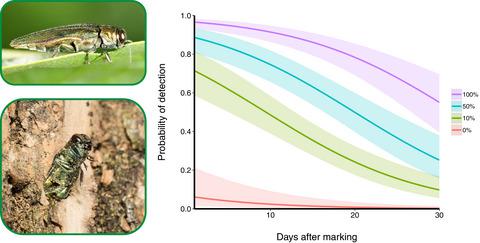当前位置:
X-MOL 学术
›
Entomol. Exp. Appl.
›
论文详情
Our official English website, www.x-mol.net, welcomes your
feedback! (Note: you will need to create a separate account there.)
Protein self‐marking by emerald ash borer: an evaluation of efficacy and persistence
Entomologia Experimentalis et Applicata ( IF 1.4 ) Pub Date : 2020-06-16 , DOI: 10.1111/eea.12941 Scott W. Gula 1 , Vanessa M. Lopez 2 , Ann M. Ray 3 , Scott A. Machtley 4 , James R. Hagler 4 , Matthew D. Ginzel 1
Entomologia Experimentalis et Applicata ( IF 1.4 ) Pub Date : 2020-06-16 , DOI: 10.1111/eea.12941 Scott W. Gula 1 , Vanessa M. Lopez 2 , Ann M. Ray 3 , Scott A. Machtley 4 , James R. Hagler 4 , Matthew D. Ginzel 1
Affiliation

|
Understanding the dispersal ability of invasive insects provides useful insights for developing effective management strategies. Historically, methods for marking insects for dispersal studies have been expensive, time‐consuming, labor‐intensive, and oftentimes ineffective, especially for woodboring beetles. Also, capturing or rearing insects requires human handling, which can alter behavior. Protein immunomarking is a well‐established technique for studying the dispersal of insects; however, it has not been applied to woodborers. This study evaluates the potential for using protein immunomarkers applied directly to woodborer‐infested trees to mark emerging beetles. Specifically, in the first experiment, we sprayed varying concentrations of ovalbumin (egg white) solution directly onto logs infested with emerald ash borer (EAB), Agrilus planipennis Fairmaire (Coleoptera: Buprestidae, Agrilini). In turn, an enzyme‐linked immunosorbent assay was used to detect the presence of protein on emerged beetles. To test the persistence of the mark, we applied varying concentrations of albumin to freeze‐killed beetles, mounted them on pins, and placed them over various time intervals in an exposed location outdoors. Adult EAB self‐marked as they emerged from protein‐treated trees, with higher protein concentrations persisting for longer on the cuticle. This technique offers a convenient, inexpensive, and durable means of marking woodborers and circumvents the need for human handling, allowing for more natural behavior and more realistic estimates of dispersal. Protein self‐marking may find application in studies of woodborer dispersal within natural forest environments.
中文翻译:

翡翠灰螟的蛋白质自标记:有效性和持久性的评估
了解入侵昆虫的传播能力为制定有效的管理策略提供了有用的见解。从历史上看,用于传播研究的标记昆虫的方法昂贵、耗时、劳动密集且通常无效,尤其是对于蛀木甲虫。此外,捕捉或饲养昆虫需要人工操作,这可能会改变行为。蛋白质免疫标记是研究昆虫传播的成熟技术。然而,它并未应用于蛀木虫。该研究评估了使用直接应用于蛀木虫感染树木的蛋白质免疫标记物来标记新出现的甲虫的潜力。具体来说,在第一个实验中,我们将不同浓度的卵清蛋白(蛋清)溶液直接喷洒到感染了祖母绿蛀虫 (EAB) 的原木上,Agrilus planipennis Fairmaire(鞘翅目:Buprestidae,Agrilini)。反过来,酶联免疫吸附试验用于检测出现的甲虫上蛋白质的存在。为了测试标记的持久性,我们将不同浓度的白蛋白应用于冻死的甲虫,将它们安装在别针上,并在不同的时间间隔内将它们放置在户外暴露的位置。成年 EAB 从经过蛋白质处理的树木中出现时会自我标记,较高的蛋白质浓度在角质层上持续时间更长。这种技术提供了一种方便、廉价且耐用的标记蛀木虫的方法,并避免了人工处理的需要,允许更自然的行为和更现实的传播估计。蛋白质自标记可用于研究天然森林环境中的蛀虫扩散。
更新日期:2020-06-16
中文翻译:

翡翠灰螟的蛋白质自标记:有效性和持久性的评估
了解入侵昆虫的传播能力为制定有效的管理策略提供了有用的见解。从历史上看,用于传播研究的标记昆虫的方法昂贵、耗时、劳动密集且通常无效,尤其是对于蛀木甲虫。此外,捕捉或饲养昆虫需要人工操作,这可能会改变行为。蛋白质免疫标记是研究昆虫传播的成熟技术。然而,它并未应用于蛀木虫。该研究评估了使用直接应用于蛀木虫感染树木的蛋白质免疫标记物来标记新出现的甲虫的潜力。具体来说,在第一个实验中,我们将不同浓度的卵清蛋白(蛋清)溶液直接喷洒到感染了祖母绿蛀虫 (EAB) 的原木上,Agrilus planipennis Fairmaire(鞘翅目:Buprestidae,Agrilini)。反过来,酶联免疫吸附试验用于检测出现的甲虫上蛋白质的存在。为了测试标记的持久性,我们将不同浓度的白蛋白应用于冻死的甲虫,将它们安装在别针上,并在不同的时间间隔内将它们放置在户外暴露的位置。成年 EAB 从经过蛋白质处理的树木中出现时会自我标记,较高的蛋白质浓度在角质层上持续时间更长。这种技术提供了一种方便、廉价且耐用的标记蛀木虫的方法,并避免了人工处理的需要,允许更自然的行为和更现实的传播估计。蛋白质自标记可用于研究天然森林环境中的蛀虫扩散。











































 京公网安备 11010802027423号
京公网安备 11010802027423号